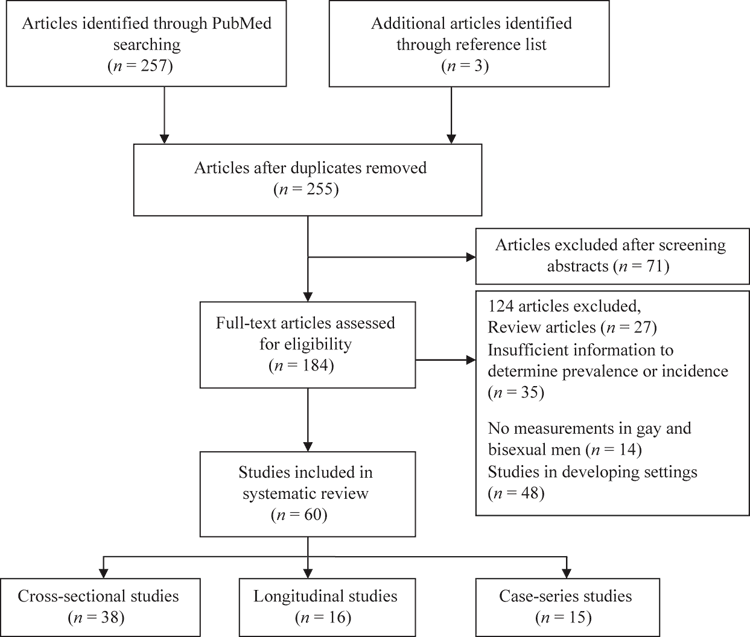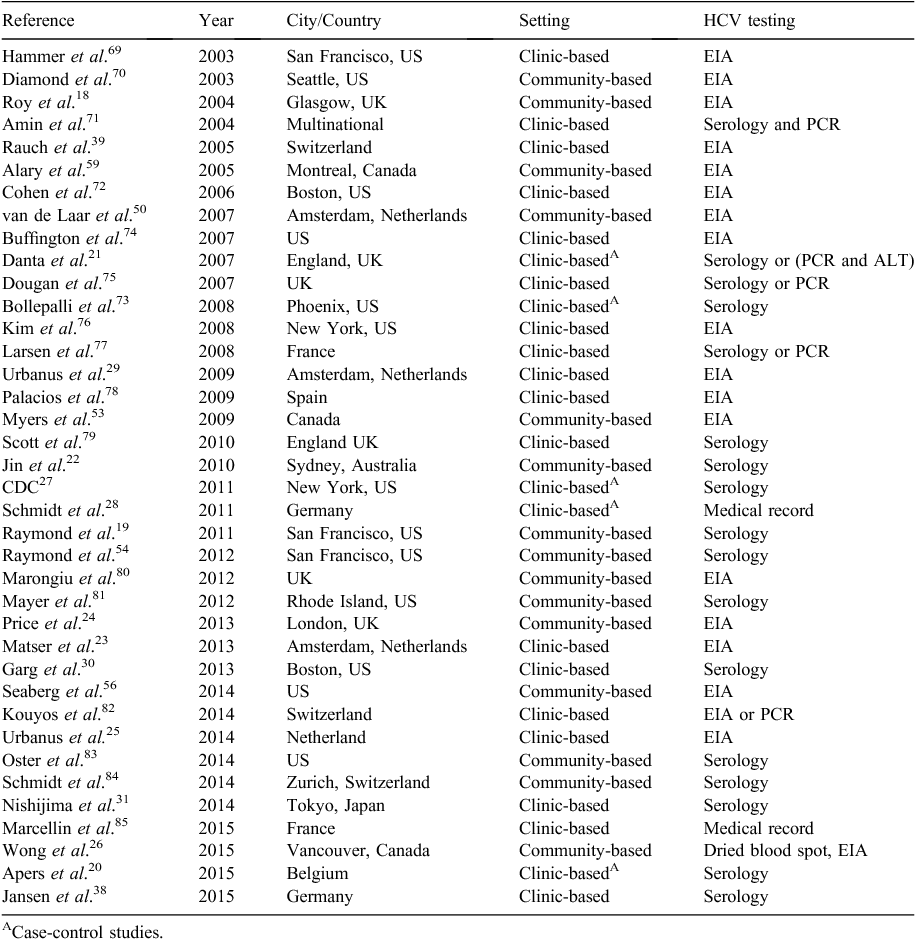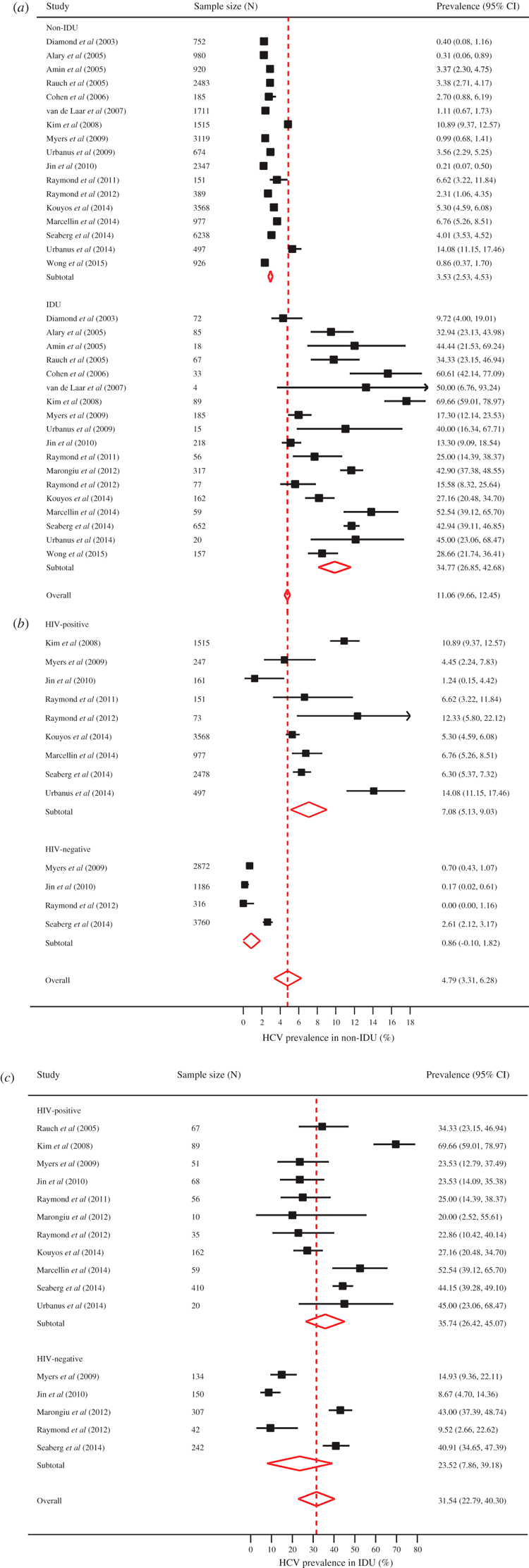Sexual transmission of hepatitis C virus among gay and bisexual men: a systematic review
Fengyi Jin A B , Gail V. Matthews A and Andrew E. Grulich AA The Kirby Institute, Wallace Wurth Building, University of New South Wales, Sydney, NSW 2052, Australia.
B Corresponding author. Email: jjin@kirby.unsw.edu.au
Sexual Health 14(1) 28-41 https://doi.org/10.1071/SH16141
Submitted: 12 July 2016 Accepted: 14 August 2016 Published: 7 October 2016
Journal Compilation © CSIRO Publishing 2017 Open Access CC BY-NC-ND
Abstract
A systematic review was performed on the evidence of sexual transmission of hepatitis C virus (HCV) in gay and bisexual men (GBM). Studies conducted in industrialised countries and published in English from 2000 to 2015 with data on HCV in GBM were included. Pooled estimates of prevalence and incidence of HCV infection were stratified by study settings and participants’ HIV status using random effect models. Case-series reports were summarised descriptively. Of the 38 cross-sectional studies, the pooled HCV prevalence was substantially higher in HIV-positive men (8.3%, 95% CI: 6.7–9.9) than in HIV-negative men (1.5%, 95% CI 0.8–2.1), and higher in those who reported injecting drug use (34.8%, 95% CI 26.9–42.7) than in those who did not (3.5%, 95% CI 2.4–4.5). Of the 16 longitudinal studies, the pooled HCV incidence was markedly higher in clinic-based (7.0 per 1000 person-years, 95% CI 4.6–9.5) than in community-based (1.4 per 1000 person-years, 95% CI 0.7–2.1) studies, and in HIV-positive men (6.4 per 1000 person-years, 95% CI 4.6–8.1) than in HIV-negative men (0.4 per 1000 person-years, 95% CI 0–0.9). Since the early 2000s, 15 case-series reports increasingly pointed to the importance of sexual transmission of HCV in mainly HIV-positive men. Injecting drug use remained the major transmission route of HCV in GBM. Receptive condomless intercourse and concurrent ulcerative sexually transmissible infections are likely drivers that facilitated HCV sexual transmission in HIV-positive men. HCV incidence remains very low in HIV-negative GBM.
Additional keywords: homosexuality, male, injecting drug use, pooled estimate, risk factors.
Introduction
Hepatitis C is a liver disease caused by hepatitis C virus (HCV) infection. Among 18–34% of those with acute HCV infection will spontaneously clear the virus within 6 months;1 however, the remaining will become chronic and approximately 25% of chronic HCV infection will lead to liver cirrhosis. Approximately 25% of those with liver cirrhosis will eventually develop end-stage liver disease or liver cancer.1,2 Globally, ~130–150 million people are living with chronic HCV infection.3 In Australia, this figure was estimated to be 230 470 in 2014.4
Parenteral exposures have long been established as the main transmission mode for HCV, primarily among injecting drug users (IDU) and in blood transfusion recipients. The latter has been largely eradicated in industrialised countries since the advent and the implementation of routine HCV serological testing among blood donors in the early 1990s.5
The extent to which this virus can be transmitted through sexual contact has been controversial.6 Early studies focusing on sexual partners of HCV-infected haemophiliac index cases reported low HCV prevalence, but slightly higher prevalence was observed in partners in which the index cases were HCV/HIV co-infected.7 Other studies among sexual partners of non-haemophiliac index cases and sexual health clinic attendees showed slight excesses of HCV prevalence in those high-risk populations.7 Nevertheless, the risk of parenteral transmission could not be ruled out in these studies, as IDU may be over-represented in the study populations.
Gay and bisexual men (GBM) are particularly vulnerable to sexually transmissible infections (STI) due to higher exposure to new sexual partners.8 HIV-positive GBM men have an even higher burden of STIs.9 The prevalence of HCV infection is also markedly higher in those living with HIV compared with their HIV-negative counterparts.10 Up until recently, the higher incidence of HCV infection appears to be limited to HIV-positive GBM.10 Why higher incidence is limited to HIV-positive men is unclear, but potential reasons included behavioural factors, such as higher rates of condomless anal intercourse (CAI) mainly with other HIV-positive partners,11 and biological factors, such as higher HCV viral load in semen in addition to lower immunity,12 in HIV-positive than in HIV-negative GBM. However, this may change because of the implementation of pre-exposure prophylaxis (PrEP) aimed at high-risk HIV-negative GBM as a means of biomedical HIV prevention.13,14 There are concerns that high-risk HIV-negative GBM might be at increased risk of HCV infection via sexual contact by having CAI with HCV/HIV co-infected partners.15,16
This systematic review set out to summarise evidence published since the year 2000 on the risk of HCV infection in GBM.
Methods
Eligibility criteria
This review considered full text articles published from 2000 to 2015 with data on HCV prevalence or incidence or risk factors in GBM. Eligible articles included original research and letters to the editor. Only studies conducted in industrialised countries and written in English were considered. Articles used self-reported HCV status only, with no laboratory confirmation of infection were excluded. For studies concerning HIV-positive individuals, only those that presented data separately for HIV-positive GBM were included.
Information sources
A literature review was conducted on PubMed for the period between 1 January 2000 and 31 December 2015. Articles in the reference list of published papers that were published in the same period were also searched.
Search
The following keywords were used to search articles: (gay OR homosexuality, male) AND (HCV OR hepatitis C) AND (prevalence OR incidence OR risk factors).
Study selection
Article titles and abstracts were reviewed for inclusion, based on the inclusion and exclusion criteria. Studies were included in the review if they had quantitative measures of the variables of interest and were undertaken for populations that included HIV-positive or HIV-negative men who were described as homosexual, bisexual or men who have sex with men.
Data collection process
A data abstraction table was used to record data from articles, as recommended by the Preferred Reporting Items for Systematic Reviews and Meta-Analyses (PRISMA) guidelines.17
Data items
Data were recorded separately for studies of various designs, including case-series reports, cross-sectional and longitudinal studies. First author, the year of publication, and the city and country of the origin of the study were recorded for all studies. For case-series reports, extra data points included: number of cases, number of cases who were HIV-positive, proportion of cases who were non-IDU and potential risk factors that contributed to HCV acquisition. For cross-sectional studies, extra data points included: study settings (community- or clinic-based), methods of HCV testing, overall sample size and HCV prevalence, then stratified by IDU and HIV status, and other risk factors identified. HCV prevalence was not recorded for case-control studies. For longitudinal studies, extra data points included: study settings, methods of HCV testing, overall sample size, person-years and HCV incidence, then stratified by IDU and HIV status, and other risk factors identified.
Summary measures
In cross-sectional studies, HCV prevalence was presented as a percentage of participants who tested HCV positive among the total number tested. In longitudinal studies, HCV incidence was presented as the number of participants who had acquired HCV infection divided by per 1000 person-years of follow up.
Statistical analysis
The prevalence and incidence of HCV infection were summarised in forest plots. Pooled prevalence and incidence and their 95% confidence intervals (CI) were estimated using random effect models because of the high heterogeneities expected arising from a diversity of study populations and HCV testing methods. Pooled estimates were stratified by study settings and participants’ HIV status. For cross-sectional studies, there was an additional stratification by drug injecting status. The stratification by drug injecting status was not summarised in a forest plot for longitudinal studies because only a few studies (n = 3) had this information available.
Results
A total of 260 studies were identified, of which 65 studies fit the selection criteria and 60 were included in the systematic review after the removal of five repeat studies (Fig. 1). Seven studies were included in both cross-sectional and longitudinal reviews, and two were included in both cross-sectional and case-series reports.
Cross-sectional studies
Thirty-eight studies were included, including five case-control studies (Table 1).
HCV prevalence stratified by study setting
Among 14 studies that recruited GBM from community-based settings, HCV prevalence ranged between 0 and 11.6%, with a pooled prevalence of 3.4% (95% CI: 2.1–4.7; Fig. 2). The study that reported a zero prevalence involved non-injecting partners of IDUs in Scotland and included only 12 GBM.18 The study that reported the highest HCV prevalence at 11.6% tested serum collected as part of the US National HIV Behavioural Surveillance system (NHBS) in 2004 and 2008 from HIV-positive GBM in San Francisco.19 Apart from this study, HCV prevalence in community-recruited GBM was generally under 5%. In 18 studies that recruited participants from clinic-based settings, HCV prevalence ranged between 0.7 and 14.2%, with a pooled prevalence of 5.7% (95% CI: 4.2–7.2, Fig. 2).
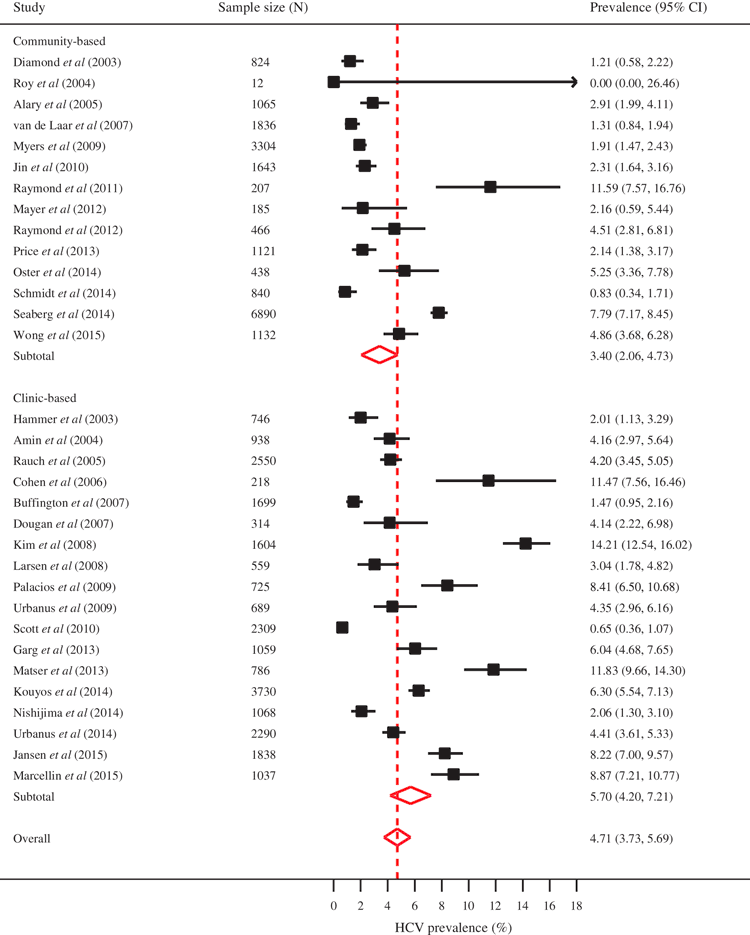
|
HCV prevalence stratified by HIV status
In HIV-negative men, HCV prevalence ranged between 0.6% and 5.6% among 14 studies. The majority (10 studies) reported a prevalence of under 1.5%, and the pooled prevalence was 1.5% (95% CI: 0.8–2.1, Fig. 3). The pooled HCV prevalence in HIV-positive GBM among 26 studies was markedly higher at 8.3% (95% CI: 6.7–9.9, Fig. 3). Close to half of the studies (11 studies) reported a prevalence of above 10% in HIV-positive men.
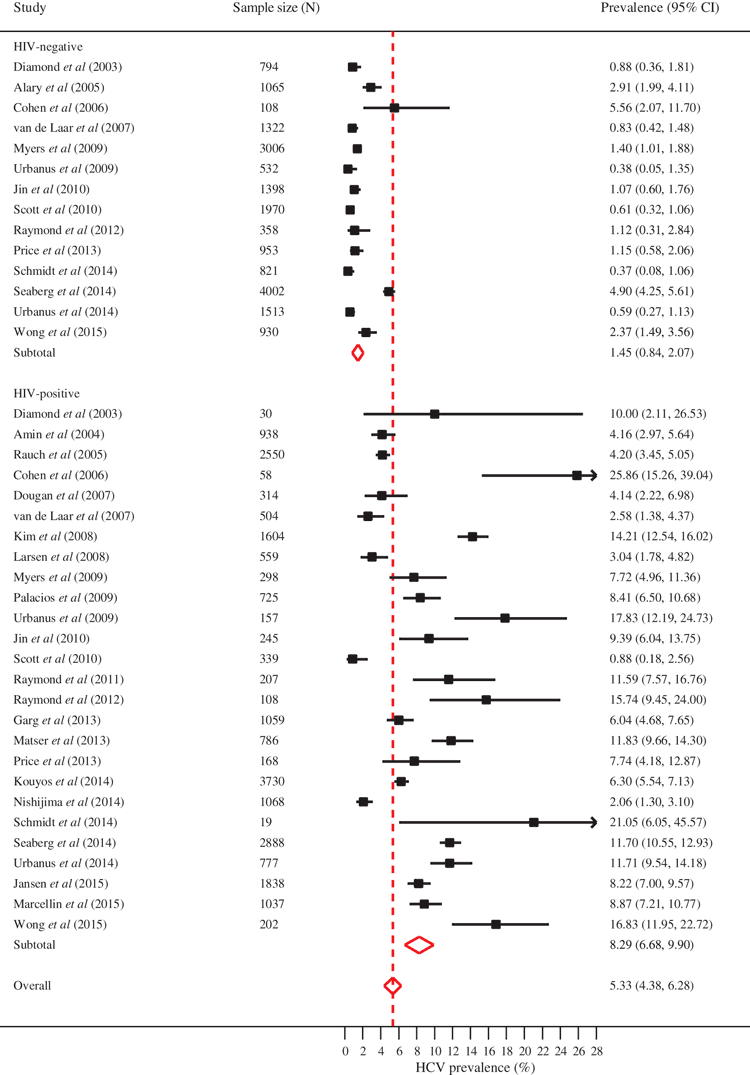
|
HCV prevalence stratified by drug injecting status
There was a striking difference in pooled HCV prevalence between GBM who did and who did not report a history of injecting drug use. A total of 17 studies included participants who were non-IDUs, and HCV prevalence was reported to be under 5% in 12 studies, with a pooled prevalence of 3.5% (95% CI: 2.5–4.5, Fig. 4a). In contrast, the majority (14 studies) of the 18 studies that had data in IDUs reported a prevalence of above 20%, with a pooled prevalence of 34.8% (95% CI: 26.9–42.7, Fig. 4a). Among those who did not report injecting drug use, the pooled prevalence in HIV-negative men was 0.9% (95% CI: 0.0–1.8) and 7.1% (95% CI: 5.1–9.0) in HIV-positive men (Fig. 4b). In IDUs, the pooled prevalence was similar between HIV-negative (23.5%, 95% CI: 7.9–39.2) and HIV-positive men (35.7%, 95% CI: 26.4–45.1, Fig. 4c).
Other risk factors in addition to injecting drug use
A history of STIs was associated with HCV prevalence in seven studies.20–26 Receptive CAI was reported as a risk factor for prevalent HCV infection in five studies,21,24–27 and in two of them, the association was independent of injecting drug use.25,26 Traumatic sexual practices, such as fisting, were also identified as a risk factor in five studies.20,21,25,28,29
Longitudinal studies
Sixteen studies were included (Table 2).
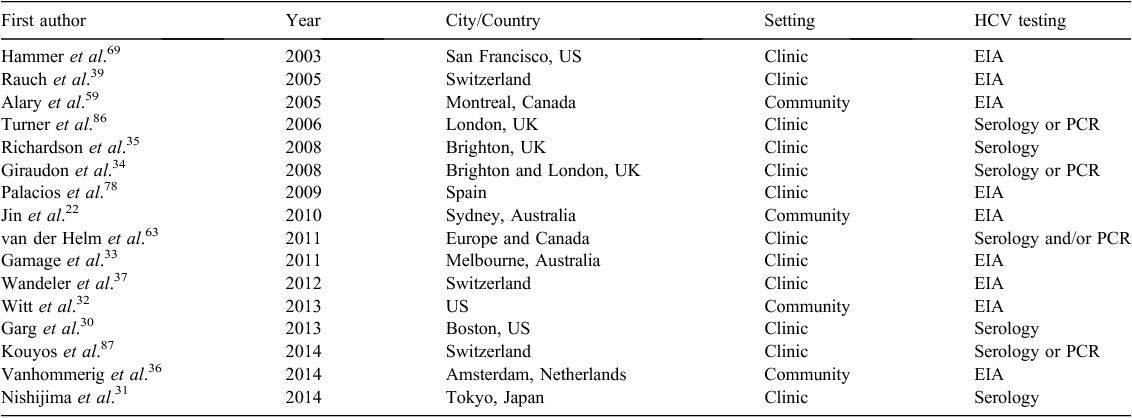
|
HCV incidence stratified by study setting
In four longitudinal studies that recruited GBM from the community, the HCV incidence ranged between 0.4 and 2.1 per 1000 person-years, with a pooled incidence of 1.4 per 1000 person-years (95% CI: 0.7–2.1, Fig. 5). This is markedly lower than the pooled incidence of 7.0 per 1000 person-years (95% CI: 4.6–9.5) arising from nine cohort studies conducted in clinics (Fig. 5). The highest incidence was reported in 379 HIV-positive men attending a community healthcare centre in Boston, US. There was more than 1480 person-years of follow up in this study; 23 men seroconverted, hence an incidence rate of 16.3 per 1000 person-years.30
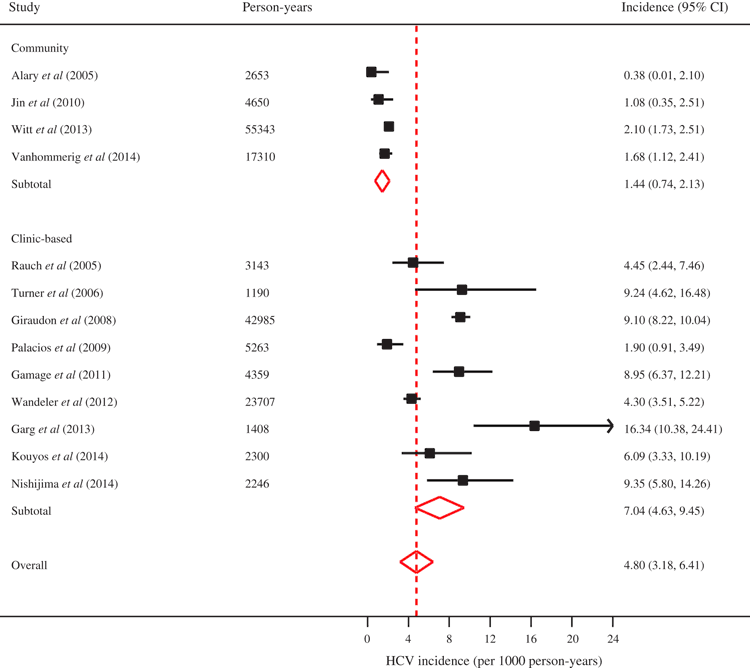
|
HCV incidence stratified by HIV status
In five longitudinal studies that recruited HIV-negative GBM, the pooled HCV incidence was 0.4 per 1000 person-years (95% CI: 0–0.9, Fig. 6). One Dutch study followed 1565 initially HIV-negative men for a total of 10 888 person-years between 1982 and 2012, and reported no seroconversions to HCV. In 13 studies that recruited HIV-positive men, the pooled HCV incidence was substantially higher at 6.4 per 1000 person-years (95% CI: 4.6–8.1, Fig. 6). In five studies, the reported HCV incidence was above 9 per 1000 person-years.
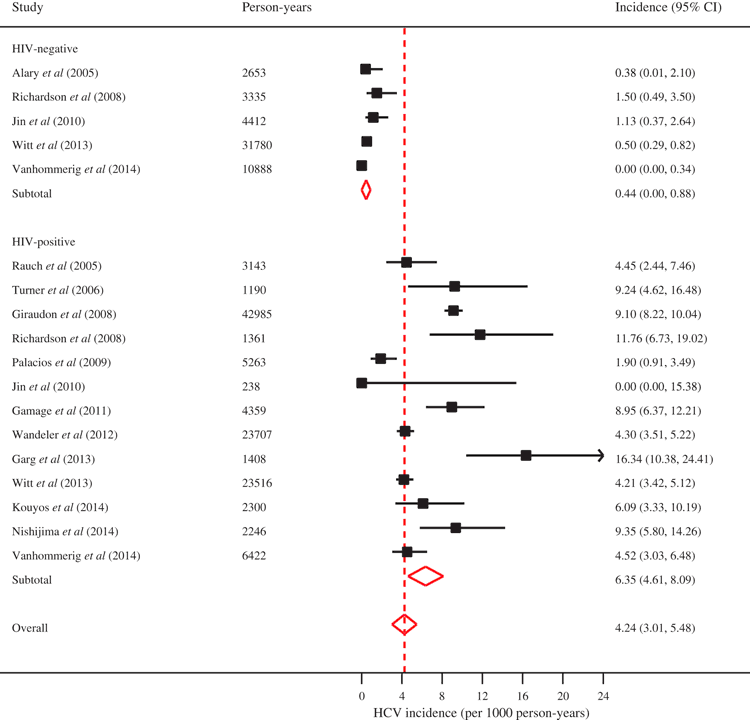
|
Injecting drug use as a risk factor
Injecting drug use was examined as a risk factor for incident HCV infection in three studies. Among 1182 HIV-positive men, a clinic-based study in Japan reported an HCV incidence of 7.9 and 40.0 per 1000 person-years in non-IDUs and IDUs, respectively.31 The large-scale Multicenter AIDS Cohort in the US reported an HCV incidence of 1.6 per 1000 person-years in non-IDUs, and this was significantly higher in previous and current IDUs (6.9 and 25.8 per 1000 person-years, respectively).32 In Melbourne, Australia, 620 HIV-positive men were followed up for a total of 4359 person-years, and the incidence of HCV was significantly higher in IDUs (hazard ratio = 8.7, 95% CI 4.6–16.6).33
Other risk factors in addition to injecting drug use
An increase in HCV incidence over time, starting from the late 1990s and early 2000s, was highlighted in five studies, all of which were conducted in Europe.34–38 Similar to cross-sectional studies, CAI32,37,39 and a history of syphilis32,37 were also reported as risk factors for incident HCV infection. However, the association with CAI was only significant in non-IDU in one Swiss clinic-based study of 1543 HIV-positive men.39
Case-series reports
Since the early 2000s, case-series reports of acute HCV infection among mainly HIV-positive GBM began to surface. A total of 15 reports were included in this review (Table 3). The first report emerged in France, with five men presenting with infectious syphilis who also acquired acute HCV infection.40 All denied a history of injecting drug use, but CAI was identified as an important risk factor. Shortly afterwards, similar findings were echoed in other studies from major cities in Europe,41–50 Australia,51,52 and the US.16,27 The number of cases in these reports ranged from 2 to 74 men. Until recently,16,47 nearly all men in these cases were HIV positive. In 11 of these studies, over 90% of the men were non-IDUs,27,41–50 and co-diagnoses with ulcerative STIs were common, including syphilis,40,42–44,50 lymphogranuloma venereum (LGV)42,46,50 and genital herpes.44,50 Traumatic sexual practices were also frequently reported, particularly fisting.44,46,50 In 2015, McFaul et al. summarised 42 cases of acute HCV infection diagnosed in Europe between 2010 and 2014 who were HIV-negative GBM,47 with nearly 80% being non-IDU. Almost all (93%) reported CAI, and one-quarter reported fisting. A co-existing rectal or ulcerative STI was diagnosed in nearly one-third (29.5%). This report also noted that eight men received post-exposure HIV prophylaxis within 6 months before acute HCV infection, and two men were participants of a PrEP trial in the UK. In the same year, Volk et al. also reported two cases of acute HCV infection among participants of a PrEP trial in the US who also denied a history of injecting drug use;16 both were diagnosed with syphilis and rectal STIs on numerous occasions during the study.
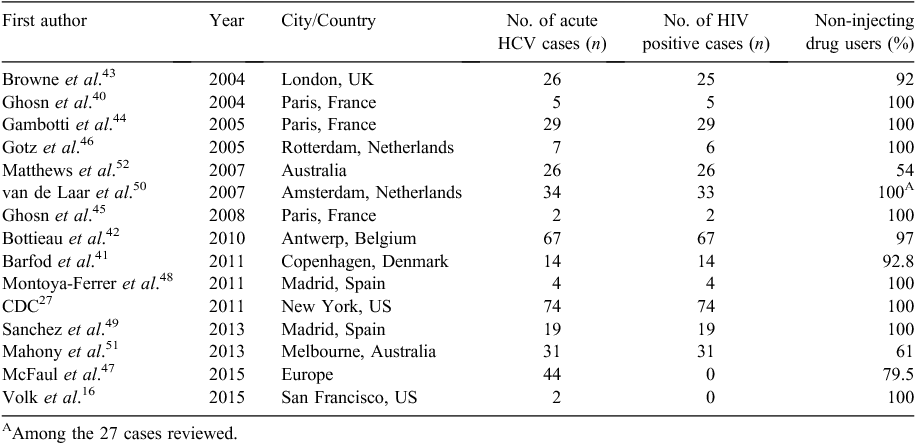
|
Discussion
Hepatitis C virus prevalence varied markedly in studies concerning GBM. Overall, the pooled prevalence in studies conducted in community-based settings (3.4%, 95% CI 2.1–4.7) was similar to that of clinic-based settings (5.7%, 95% CI 4.2–7.2). In contrast, there was a substantial difference in pooled prevalence between HIV-negative (1.5%, 95% CI 0.8–2.1) and HIV-positive (8.3%, 95% CI 6.7–9.9) men. Injecting drug use remained the major transmission route for HCV infection in the gay communities, as demonstrated by a 10-fold increase in pooled prevalence between non-IDUs (3.5%, 95% CI 2.5–4.5) and IDUs (34.8%, 95% CI 26.9–42.7). Approximately one-third of GBM who had a history of injecting drug use were HCV-positive regardless of their HIV status. In longitudinal studies, the pooled annual incidence was just under 5 per 1000 person-years in GBM (4.8 per 1000 person-years, 95% CI 3.2–6.4), and HIV-positive men had a pooled incidence more than 15-fold higher than HIV-negative men (6.4 vs 0.4 per 1000 person-years). In case-series reports, since 2000, there has been a trend of increasing number of reports of clusters of mainly HIV-positive men who were likely to have acquired acute HCV infection through sexual contact. It was also likely that the acquisition could be further facilitated by the presence of ulcerative STIs, including syphilis and LGV. There have been a few recent reports of HIV-negative men who acquired acute HCV infection through sexual means, including four cases who were PrEP trial participants.
In HIV-negative GBM who do not report a history of injecting drug use, the prevalence of HCV is generally below 1%,22,53,54 which is similar to or slight lower than that of the general population in corresponding industrialised countries.55 Nevertheless, the large-scale Multicenter AIDS Cohort (MAC) study reported a HCV prevalence of 2.6% in its HIV-negative non-IDU participants after testing stored sera.56 The majority of the participants of the MAC study were recruited in the mid-1980s, an era before the advent of HCV serological testing. It is likely that some HCV infections in HIV-negative participants could be attributable to blood transfusion.
In individuals who do not have immune-compromising conditions, the probability of acquiring HCV infection thorough sexual contact is generally low. In heterosexual couples, an Italian study followed 776 spouses of HCV-infected index cases for a mean of 10 years and reported three cases of incident HCV infection;57 however, genotyping and phylogenetic tests indicated that none were transmitted from the index partners. One more recent cohort study in the US followed 500 HCV serodiscordant heterosexual couples for a total of 8377 person-years and recorded three within-couple HCV transmissions as confirmed by a phylogenetic test.58 Although there are no cohort studies on HCV sexual transmission among male GBM couples, incident HCV infection rates reported by longitudinal studies of HIV-negative GBM have also been consistently low, with a pooled incidence of 0.4 per 1000 person-years.22,32,35,36,59
The sexual transmission of HCV is complicated by HIV infection, either in the index or in the susceptible partner. In early cross-sectional studies of heterosexual couples in which the index partners were haemophiliac, HCV prevalence was higher in sexual partners whereby the index partner was also HIV-infected.7 However, a more recent longitudinal study involving 171 heterosexual couples in which the index partner was HCV/HIV co-infected reported no cases of HCV acquisition.60 This was despite 529 person-years of follow up and over 5800 episodes of condomless vaginal and anal intercourse. The role of partners’ HIV status in relation to HCV acquisition in HIV-negative GBM is less clear. Although it was not statistically significant, four of five HCV seroconverters arising from a cohort of HIV-negative men in Sydney, Australia, reported sex with HIV-positive partners before HCV infection (hazard ratio 8.2, 95% CI 0.9–74.3).22 Nevertheless, only one reported CAI with the HIV-positive partner. Biological evidence showed a higher seminal HCV viral load in HCV/HIV co-infected than in HCV mono-infected men and a lower HCV clearance rate in the co-infected,12 and thus a higher likelihood of transmitting the virus to the susceptible partner. Two recent studies that investigated the role of HCV in semen demonstrated a high correlation between blood and semen HCV viral load and frequent seminal HCV viral shedding in HIV-positive GBM.61,62
Some longitudinal studies in Europe demonstrated an increase in HCV incidence in HIV-positive GBM since the late 1990s.34,35,63,64 Most of those who acquired acute HCV infection did not report a history of injecting drug use,27,41–50 with sexual contact being the mostly likely transmission route in these individuals. Behaviourally, this has coincided with the increasing practice of CAI and esoteric sexual practices, such as fisting, between partners of the same HIV status in the form of serosorting with the aim to minimise the HIV risk.65,66 Biologically, this has also co-existed with a resurgence of ulcerative STIs, including syphilis and LGV, in HIV-positive communities in the same region.67
We have yet to see an increase in HCV incidence in HIV-negative GBM, but there have been a few recent case-series reports of acute HCV infection in this population, particularly in participants of PrEP trials.16,47 Individuals receiving PrEP may decide not to use condoms with a male partner of the opposite HIV status. As an untoward consequence, rates of STIs could rise in HIV-negative men due to increases in anal intercourse between the HIV-negative and -positive men; that is, they are not protected by condom use.15 Given that sexual transmission of HCV can occur in HIV-negative GBM men, this is of concern. In the context of PrEP, it is likely to be facilitated by increased sexual contact with HIV-positive partners in the form of CAI and in the presence of ulcerative STIs. While more evidence is needed to determine to what extent this might occur, surveillance should be in place to monitor HCV status in PrEP recipients. In its PrEP guidelines, the US Centres for Disease Control and Prevention acknowledges HCV risk in GBM and recommends HCV testing before PrEP is prescribed to document HCV status,13 but no regular follow-up HCV tests are recommended once PrEP is initiated. In its most recent revision, PrEP guidelines for the Australian state of New South Wales recommend screening at baseline and during follow up in men who report potential risk factors for transmission.68
This review has focused on HCV risk in GBM in industrialised countries, so the results might be of limited generalisability in other settings. Even with this restriction on the scope of the review, substantial heterogeneities were observed in studies of HCV prevalence and incidence in GBM. In addition to injecting drug use, HIV status and study settings that have been examined in the analyses; other sources might have also contributed to the diversity of the rates observed between the studies, such as the geographic region and the age composition of the study population. Although injecting drug use remains the major transmission route for HCV infection, information on drug injecting was not always presented. A history of injecting drug use was generally self-reported by the study participants. As injecting drug use is probably associated with more stigma than CAI in the gay community, it is likely that the levels of drug injecting were underreported. This might have led to an underestimation of injecting drug use-associated HCV risk. Although all cases of HCV infection were confirmed by laboratory testing or medical records, various tests involved usually carry different performance characteristics. In older studies, HCV testing might be less sensitive than the ones used in more recent studies. It is also a possibility that studies that did not employ supplementary, more sensitive PCR testing might have missed cases of early HCV infection. In relation to ulcerative STIs as risk factors for HCV acquisition, particularly for the association with LGV, the conclusion relies on case-series reports. There have been no cross-sectional or longitudinal studies conducted in GBM to explicitly examine this association.
The risk for HCV infection in GBM who do not report a history of injecting drug use is generally low. Sexual transmission of HCV cannot be ruled out in this population, particularly in those with HIV infection in whom levels of CAI and rates of ulcerative STI are usually higher. In HIV-negative GBM, HCV sexual transmission can occur, and this could be further facilitated by the implementation of PrEP as a biomedical means for HIV prevention. For individual and public health considerations, HCV status should be determined before and monitored during PrEP use.
Conflicts of interest
None declared.
Funding
The Kirby Institute is affiliated with the Faculty of Medicine, University of New South Wales and funded by the Australian Government of Health and Ageing. The views expressed in this publication do not necessarily represent the position of the Australian Government. This project was funded by the New South Wales Sexually Transmitted Infections in Gay Men Action Group.
References
[1] Westbrook RH, Dusheiko G. Natural history of hepatitis C. J Hepatol 2014; 61 S58–68.| Natural history of hepatitis C.Crossref | GoogleScholarGoogle Scholar | 25443346PubMed |
[2] Klevens RM, Hu DJ, Jiles R, et al Evolving epidemiology of hepatitis C virus in the United States. Clin Infect Dis 2012; 55 S3–9.
| Evolving epidemiology of hepatitis C virus in the United States.Crossref | GoogleScholarGoogle Scholar | 22715211PubMed |
[3] World Health Organization. Hepatitis C fact sheet. Geneva: WHO; 2016.
[4] The Kirby Institute. HIV, viral hepatitis and sexually transmissible infections in Australia: annual surveillance report 2015. Sydney: The Kirby Institute, UNSW; 2015.
[5] Follett EA, Dow BC, McOmish F, et al HCV confirmatory testing of blood donors. Lancet 1992; 339 928–8.
| HCV confirmatory testing of blood donors.Crossref | GoogleScholarGoogle Scholar | 1:STN:280:DyaK383ht1Siuw%3D%3D&md5=7de66635f5da556a6681491dd5f14f72CAS | 1348314PubMed |
[6] Alter MJ, Coleman PJ, Alexander WJ, et al Importance of heterosexual activity in the transmission of hepatitis B and non-A, non-B hepatitis. JAMA 1989; 262 1201–5.
| Importance of heterosexual activity in the transmission of hepatitis B and non-A, non-B hepatitis.Crossref | GoogleScholarGoogle Scholar | 1:STN:280:DyaL1Mzkt1Oksw%3D%3D&md5=0e7960ebb587be96cab403f14aed2f97CAS | 2503630PubMed |
[7] Tibbs CJ. Methods of transmission of hepatitis C. J Viral Hepat 1995; 2 113–9.
| Methods of transmission of hepatitis C.Crossref | GoogleScholarGoogle Scholar | 1:STN:280:DyaK28%2FptFeiug%3D%3D&md5=5d2a96c780f9a704ce60ab89a739acb9CAS | 7493305PubMed |
[8] Grulich AE, de Visser RO, Smith AM, et al Sex in Australia: homosexual experience and recent homosexual encounters. Aust N Z J Public Health 2003; 27 155–63.
| Sex in Australia: homosexual experience and recent homosexual encounters.Crossref | GoogleScholarGoogle Scholar | 14696706PubMed |
[9] Jin F, Prestage GP, Zablotska I, et al High rates of sexually transmitted infections in HIV positive homosexual men: data from two community based cohorts. Sex Transm Infect 2007; 83 397–9.
| High rates of sexually transmitted infections in HIV positive homosexual men: data from two community based cohorts.Crossref | GoogleScholarGoogle Scholar | 17556503PubMed |
[10] Yaphe S, Bozinoff N, Kyle R, et al Incidence of acute hepatitis C virus infection among men who have sex with men with and without HIV infection: a systematic review. Sex Transm Infect 2012; 88 558–64.
| Incidence of acute hepatitis C virus infection among men who have sex with men with and without HIV infection: a systematic review.Crossref | GoogleScholarGoogle Scholar | 22859499PubMed |
[11] Mao L, Kippax SC, Holt M, et al Rates of condom and non-condom-based anal intercourse practices among homosexually active men in Australia: deliberate HIV risk reduction? Sex Transm Infect 2011; 87 489–93.
| Rates of condom and non-condom-based anal intercourse practices among homosexually active men in Australia: deliberate HIV risk reduction?Crossref | GoogleScholarGoogle Scholar | 21764890PubMed |
[12] Danta M, Rodger AJ. Transmission of HCV in HIV-positive populations. Curr Opin HIV AIDS 2011; 6 451–8.
| Transmission of HCV in HIV-positive populations.Crossref | GoogleScholarGoogle Scholar | 22001890PubMed |
[13] Centers for Disease Control and Prevention. Preexposure prophylaxis for the prevention of HIV infection in the United States – 2014 clinical practice guideline. Atlanta: CDC; 2014.
[14] Holmes D. FDA paves the way for pre-exposure HIV prophylaxis. Lancet 2012; 380 325-5
| FDA paves the way for pre-exposure HIV prophylaxis.Crossref | GoogleScholarGoogle Scholar |
[15] Scott HM, Klausner JD. Sexually transmitted infections and pre-exposure prophylaxis: challenges and opportunities among men who have sex with men in the US. AIDS Res Ther 2016; 13 5
| Sexually transmitted infections and pre-exposure prophylaxis: challenges and opportunities among men who have sex with men in the US.Crossref | GoogleScholarGoogle Scholar | 26793265PubMed |
[16] Volk JE, Marcus JL, Phengrasamy T, et al Incident hepatitis C virus infections among users of HIV preexposure prophylaxis in a clinical practice setting. Clin Infect Dis 2015; 60 1728–9.
| Incident hepatitis C virus infections among users of HIV preexposure prophylaxis in a clinical practice setting.Crossref | GoogleScholarGoogle Scholar | 25694649PubMed |
[17] Moher D, Liberati A, Tetzlaff J, et al Preferred reporting items for systematic reviews and meta-analyses: the PRISMA statement. PLoS Med 2009; 6 e1000097
| Preferred reporting items for systematic reviews and meta-analyses: the PRISMA statement.Crossref | GoogleScholarGoogle Scholar | 19621072PubMed |
[18] Roy KM, Goldberg DJ, Hutchinson S, et al Hepatitis C virus among self declared non-injecting sexual partners of injecting drug users. J Med Virol 2004; 74 62–6.
| Hepatitis C virus among self declared non-injecting sexual partners of injecting drug users.Crossref | GoogleScholarGoogle Scholar | 1:STN:280:DC%2BD2czlsFClsg%3D%3D&md5=6d8ebf5374cd334a19a07d34df03a187CAS | 15258969PubMed |
[19] Raymond HF, Hughes A, O’Keefe K, et al Hepatitis C prevalence among HIV-positive MSM in San Francisco: 2004 and 2008. Sex Transm Dis 2011; 38 219–20.
| Hepatitis C prevalence among HIV-positive MSM in San Francisco: 2004 and 2008.Crossref | GoogleScholarGoogle Scholar | 20938373PubMed |
[20] Apers L, Vanden Berghe W, De Wit S, et al Risk factors for HCV acquisition among HIV-positive MSM in Belgium. J Acquir Immune Defic Syndr 2015; 68 585–93.
| Risk factors for HCV acquisition among HIV-positive MSM in Belgium.Crossref | GoogleScholarGoogle Scholar | 25763786PubMed |
[21] Danta M, Brown D, Bhagani S, et al Recent epidemic of acute hepatitis C virus in HIV-positive men who have sex with men linked to high-risk sexual behaviours. AIDS 2007; 21 983–91.
| Recent epidemic of acute hepatitis C virus in HIV-positive men who have sex with men linked to high-risk sexual behaviours.Crossref | GoogleScholarGoogle Scholar | 17457092PubMed |
[22] Jin F, Prestage GP, Matthews G, et al Prevalence, incidence and risk factors for hepatitis C in homosexual men: data from two cohorts of HIV-negative and HIV-positive men in Sydney, Australia. Sex Transm Infect 2010; 86 25–8.
| Prevalence, incidence and risk factors for hepatitis C in homosexual men: data from two cohorts of HIV-negative and HIV-positive men in Sydney, Australia.Crossref | GoogleScholarGoogle Scholar | 19841001PubMed |
[23] Matser A, Vanhommerig J, Schim van der Loeff MF, et al HIV-infected men who have sex with men who identify themselves as belonging to subcultures are at increased risk for hepatitis C infection. PLoS One 2013; 8 e57740
| HIV-infected men who have sex with men who identify themselves as belonging to subcultures are at increased risk for hepatitis C infection.Crossref | GoogleScholarGoogle Scholar | 1:CAS:528:DC%2BC3sXktFClsr8%3D&md5=7f597677393f1b2d804c22110bda748dCAS | 23469226PubMed |
[24] Price H, Gilson R, Mercey D, et al Hepatitis C in men who have sex with men in London–a community survey. HIV Med 2013; 14 578–80.
| Hepatitis C in men who have sex with men in London–a community survey.Crossref | GoogleScholarGoogle Scholar | 1:STN:280:DC%2BC3sjjvV2ruw%3D%3D&md5=d85349b70bd445b729d93cd3cff8beb6CAS | 23782450PubMed |
[25] Urbanus AT, Van De Laar TJ, Geskus R, et al Trends in hepatitis C virus infections among MSM attending a sexually transmitted infection clinic; 1995–2010. AIDS 2014; 28 781–90.
| Trends in hepatitis C virus infections among MSM attending a sexually transmitted infection clinic; 1995–2010.Crossref | GoogleScholarGoogle Scholar | 24832014PubMed |
[26] Wong J, Moore D, Kanters S, et al Seroprevalence of hepatitis C and correlates of seropositivity among men who have sex with men in Vancouver, Canada: a cross-sectional survey. Sex Transm Infect 2015; 91 430–3.
| Seroprevalence of hepatitis C and correlates of seropositivity among men who have sex with men in Vancouver, Canada: a cross-sectional survey.Crossref | GoogleScholarGoogle Scholar | 25872512PubMed |
[27] Centers for Disease Control and Prevention Sexual transmission of hepatitis C virus among HIV-infected men who have sex with men — New York City, 2005–2010. MMWR Morb Mortal Wkly Rrp 2011; 60 945–50.
[28] Schmidt AJ, Rockstroh JK, Vogel M, et al Trouble with bleeding: risk factors for acute hepatitis C among HIV-positive gay men from Germany – a case-control study. PLoS One 2011; 6 e17781
| Trouble with bleeding: risk factors for acute hepatitis C among HIV-positive gay men from Germany – a case-control study.Crossref | GoogleScholarGoogle Scholar | 1:CAS:528:DC%2BC3MXjsFGrs70%3D&md5=f07bde11136e6923a4041743f1f8fdb9CAS | 21408083PubMed |
[29] Urbanus AT, van de Laar TJ, Stolte IG, et al Hepatitis C virus infections among HIV-infected men who have sex with men: an expanding epidemic. AIDS 2009; 23 F1–7.
| Hepatitis C virus infections among HIV-infected men who have sex with men: an expanding epidemic.Crossref | GoogleScholarGoogle Scholar | 19542864PubMed |
[30] Garg S, Taylor LE, Grasso C, et al Prevalent and incident hepatitis C virus infection among HIV-infected men who have sex with men engaged in primary care in a Boston community health center. Clin Infect Dis 2013; 56 1480–7.
| Prevalent and incident hepatitis C virus infection among HIV-infected men who have sex with men engaged in primary care in a Boston community health center.Crossref | GoogleScholarGoogle Scholar | 1:CAS:528:DC%2BC3sXntFWmsr8%3D&md5=09f1a537afa0fb3818bc475afafb8a6fCAS | 23386630PubMed |
[31] Nishijima T, Shimbo T, Komatsu H, et al Incidence and risk factors for incident hepatitis C infection among men who have sex with men with HIV-1 infection in a large urban HIV clinic in Tokyo. J Acquir Immune Defic Syndr 2014; 65 213–7.
| Incidence and risk factors for incident hepatitis C infection among men who have sex with men with HIV-1 infection in a large urban HIV clinic in Tokyo.Crossref | GoogleScholarGoogle Scholar | 24185533PubMed |
[32] Witt MD, Seaberg EC, Darilay A, et al Incident hepatitis C virus infection in men who have sex with men: a prospective cohort analysis, 1984–2011. Clin Infect Dis 2013; 57 77–84.
| Incident hepatitis C virus infection in men who have sex with men: a prospective cohort analysis, 1984–2011.Crossref | GoogleScholarGoogle Scholar | 23532480PubMed |
[33] Gamage DG, Read TR, Bradshaw CS, et al Incidence of hepatitis-C among HIV infected men who have sex with men (MSM) attending a sexual health service: a cohort study. BMC Infect Dis 2011; 11 39
| Incidence of hepatitis-C among HIV infected men who have sex with men (MSM) attending a sexual health service: a cohort study.Crossref | GoogleScholarGoogle Scholar | 21291565PubMed |
[34] Giraudon I, Ruf M, Maguire H, et al Increase in diagnosed newly acquired hepatitis C in HIV-positive men who have sex with men across London and Brighton, 2002–2006: is this an outbreak? Sex Transm Infect 2008; 84 111–5.
| Increase in diagnosed newly acquired hepatitis C in HIV-positive men who have sex with men across London and Brighton, 2002–2006: is this an outbreak?Crossref | GoogleScholarGoogle Scholar | 1:STN:280:DC%2BD1c3htVSksg%3D%3D&md5=2cd54bef49049057bbbda1631538471dCAS | 17932125PubMed |
[35] Richardson D, Fisher M, Sabin CA. Sexual transmission of hepatitis C in MSM may not be confined to those with HIV infection. J Infect Dis 2008; 197 1213–4, author reply 1214–5.
| Sexual transmission of hepatitis C in MSM may not be confined to those with HIV infection.Crossref | GoogleScholarGoogle Scholar | 18462168PubMed |
[36] Vanhommerig JW, Stolte IG, Lambers FA, et al Stabilizing incidence of hepatitis C virus infection among men who have sex with men in Amsterdam. J Acquir Immune Defic Syndr 2014; 66 e111–5.
| Stabilizing incidence of hepatitis C virus infection among men who have sex with men in Amsterdam.Crossref | GoogleScholarGoogle Scholar | 24853305PubMed |
[37] Wandeler G, Gsponer T, Bregenzer A, et al Hepatitis C virus infections in the Swiss HIV Cohort Study: a rapidly evolving epidemic. Clin Infect Dis 2012; 55 1408–16.
| Hepatitis C virus infections in the Swiss HIV Cohort Study: a rapidly evolving epidemic.Crossref | GoogleScholarGoogle Scholar | 22893583PubMed |
[38] Jansen K, Thamm M, Bock CT, et al High prevalence and high incidence of coinfection with hepatitis B, hepatitis C, and syphilis and low rate of effective vaccination against hepatitis B in HIV-positive men who have sex with men with known date of HIV seroconversion in Germany. PLoS One 2015; 10 e0142515
| High prevalence and high incidence of coinfection with hepatitis B, hepatitis C, and syphilis and low rate of effective vaccination against hepatitis B in HIV-positive men who have sex with men with known date of HIV seroconversion in Germany.Crossref | GoogleScholarGoogle Scholar | 26555244PubMed |
[39] Rauch A, Rickenbach M, Weber R, et al Unsafe sex and increased incidence of hepatitis C virus infection among HIV-infected men who have sex with men: the Swiss HIV Cohort Study. Clin Infect Dis 2005; 41 395–402.
| Unsafe sex and increased incidence of hepatitis C virus infection among HIV-infected men who have sex with men: the Swiss HIV Cohort Study.Crossref | GoogleScholarGoogle Scholar | 16007539PubMed |
[40] Ghosn J, Pierre-Francois S, Thibault V, et al Acute hepatitis C in HIV-infected men who have sex with men. HIV Med 2004; 5 303–6.
| Acute hepatitis C in HIV-infected men who have sex with men.Crossref | GoogleScholarGoogle Scholar | 1:STN:280:DC%2BD2czmtlCqsQ%3D%3D&md5=cb5e74e9f8c0607f1fd60d5c3c730de1CAS | 15236621PubMed |
[41] Barfod TS, Omland LH, Katzenstein TL. Incidence and characteristics of sexually transmitted acute hepatitis C virus infection among HIV-positive men who have sex with men in Copenhagen, Denmark during four years (2006–2009): a retrospective cohort study. Scand J Infect Dis 2011; 43 145–8.
| Incidence and characteristics of sexually transmitted acute hepatitis C virus infection among HIV-positive men who have sex with men in Copenhagen, Denmark during four years (2006–2009): a retrospective cohort study.Crossref | GoogleScholarGoogle Scholar | 20923257PubMed |
[42] Bottieau E, Apers L, Van Esbroeck M, et al Hepatitis C virus infection in HIV-infected men who have sex with men: sustained rising incidence in Antwerp, Belgium, 2001–2009. Euro Surveill 2010; 15 19673
| 1:STN:280:DC%2BC3cfnvFGqug%3D%3D&md5=0b14417b0055785d4ad353658fa75490CAS | 20929655PubMed |
[43] Browne R, Asboe D, Gilleece Y, et al Increased numbers of acute hepatitis C infections in HIV positive homosexual men; is sexual transmission feeding the increase? Sex Transm Infect 2004; 80 326–7.
| Increased numbers of acute hepatitis C infections in HIV positive homosexual men; is sexual transmission feeding the increase?Crossref | GoogleScholarGoogle Scholar | 1:STN:280:DC%2BD2czptFyjsw%3D%3D&md5=ad1bb785d2d9024e7f984da1d5fd8e78CAS | 15295139PubMed |
[44] Gambotti L, Batisse D, Colin-de-Verdiere N, et al Acute hepatitis C infection in HIV positive men who have sex with men in Paris, France, 2001–2004. Euro Surveill 2005; 10 115–7.
| 1:STN:280:DC%2BD2MvmsVKiug%3D%3D&md5=2fb454d11ba25ed59068367334d1040fCAS | 16077209PubMed |
[45] Ghosn J, Thibault V, Delaugerre C, et al Sexually transmitted hepatitis C virus superinfection in HIV/hepatitis C virus co-infected men who have sex with men. AIDS 2008; 22 658–61.
| Sexually transmitted hepatitis C virus superinfection in HIV/hepatitis C virus co-infected men who have sex with men.Crossref | GoogleScholarGoogle Scholar | 18317011PubMed |
[46] Gotz HM, van Doornum G, Niesters HG, et al A cluster of acute hepatitis C virus infection among men who have sex with men–results from contact tracing and public health implications. AIDS 2005; 19 969–74.
| A cluster of acute hepatitis C virus infection among men who have sex with men–results from contact tracing and public health implications.Crossref | GoogleScholarGoogle Scholar | 15905679PubMed |
[47] McFaul K, Maghlaoui A, Nzuruba M, et al Acute hepatitis C infection in HIV-negative men who have sex with men. J Viral Hepat 2015; 22 535–8.
| Acute hepatitis C infection in HIV-negative men who have sex with men.Crossref | GoogleScholarGoogle Scholar | 1:STN:280:DC%2BC2M3pvVKnsA%3D%3D&md5=2f1184b9f7257fcd49eb565a7f0577b3CAS | 25412826PubMed |
[48] Montoya-Ferrer A, Fierer DS, Alvarez-Alvarez B, et al Acute hepatitis C outbreak among HIV-infected men, Madrid, Spain. Emerg Infect Dis 2011; 17 1560–2.
| 21801652PubMed |
[49] Sanchez C, Plaza Z, Vispo E, et al Scaling up epidemics of acute hepatitis C and syphilis in HIV-infected men who have sex with men in Spain. Liver Int 2013; 33 1357–62.
| Scaling up epidemics of acute hepatitis C and syphilis in HIV-infected men who have sex with men in Spain.Crossref | GoogleScholarGoogle Scholar | 23730876PubMed |
[50] van de Laar TJ, van der Bij AK, Prins M, et al Increase in HCV incidence among men who have sex with men in Amsterdam most likely caused by sexual transmission. J Infect Dis 2007; 196 230–8.
| Increase in HCV incidence among men who have sex with men in Amsterdam most likely caused by sexual transmission.Crossref | GoogleScholarGoogle Scholar | 17570110PubMed |
[51] Mahony AA, Donnan EJ, Lester RA, et al Beyond injecting drug use: investigation of a Victorian cluster of hepatitis C among HIV-infected men who have sex with men. Med J Aust 2013; 198 210–4.
| Beyond injecting drug use: investigation of a Victorian cluster of hepatitis C among HIV-infected men who have sex with men.Crossref | GoogleScholarGoogle Scholar | 23451966PubMed |
[52] Matthews GV, Hellard M, Kaldor J, et al Further evidence of HCV sexual transmission among HIV-positive men who have sex with men: response to Danta et al. AIDS 2007; 21 2112–3.
| Further evidence of HCV sexual transmission among HIV-positive men who have sex with men: response to Danta et al.Crossref | GoogleScholarGoogle Scholar | 17885306PubMed |
[53] Myers T, Allman D, Xu K, et al The prevalence and correlates of hepatitis C virus (HCV) infection and HCV-HIV co-infection in a community sample of gay and bisexual men. Int J Infect Dis 2009; 13 730–9.
| The prevalence and correlates of hepatitis C virus (HCV) infection and HCV-HIV co-infection in a community sample of gay and bisexual men.Crossref | GoogleScholarGoogle Scholar | 19186090PubMed |
[54] Raymond HF, Chu P, Nieves-Rivera I, et al Hepatitis C infection among men who have sex with men, San Francisco, 2011. Sex Transm Dis 2012; 39 985–6.
| Hepatitis C infection among men who have sex with men, San Francisco, 2011.Crossref | GoogleScholarGoogle Scholar | 23191955PubMed |
[55] Gower E, Estes C, Blach S, et al Global epidemiology and genotype distribution of the hepatitis C virus infection. J Hepatol 2014; 61 S45–57.
| Global epidemiology and genotype distribution of the hepatitis C virus infection.Crossref | GoogleScholarGoogle Scholar | 25086286PubMed |
[56] Seaberg EC, Witt MD, Jacobson LP, et al Differences in hepatitis C virus prevalence and clearance by mode of acquisition among men who have sex with men. J Viral Hepat 2014; 21 696–705.
| Differences in hepatitis C virus prevalence and clearance by mode of acquisition among men who have sex with men.Crossref | GoogleScholarGoogle Scholar | 1:CAS:528:DC%2BC2MXhsVegsLrE&md5=13b5211c3add0e380c73bc55ab7166e4CAS | 25280229PubMed |
[57] Vandelli C, Renzo F, Romano L, et al Lack of evidence of sexual transmission of hepatitis C among monogamous couples: results of a 10-year prospective follow-up study. Am J Gastroenterol 2004; 99 855–9.
| Lack of evidence of sexual transmission of hepatitis C among monogamous couples: results of a 10-year prospective follow-up study.Crossref | GoogleScholarGoogle Scholar | 15128350PubMed |
[58] Terrault NA, Dodge JL, Murphy EL, et al Sexual transmission of hepatitis C virus among monogamous heterosexual couples: the HCV partners study. Hepatology 2013; 57 881–9.
| Sexual transmission of hepatitis C virus among monogamous heterosexual couples: the HCV partners study.Crossref | GoogleScholarGoogle Scholar | 23175457PubMed |
[59] Alary M, Joly JR, Vincelette J, et al Lack of evidence of sexual transmission of hepatitis C virus in a prospective cohort study of men who have sex with men. Am J Public Health 2005; 95 502–5.
| Lack of evidence of sexual transmission of hepatitis C virus in a prospective cohort study of men who have sex with men.Crossref | GoogleScholarGoogle Scholar | 15727984PubMed |
[60] Marincovich B, Castilla J, del Romero J, et al Absence of hepatitis C virus transmission in a prospective cohort of heterosexual serodiscordant couples. Sex Transm Infect 2003; 79 160–2.
| Absence of hepatitis C virus transmission in a prospective cohort of heterosexual serodiscordant couples.Crossref | GoogleScholarGoogle Scholar | 1:STN:280:DC%2BD3s7ntFyksw%3D%3D&md5=fef8821bcf79ba8420b4add9afacef5bCAS | 12690143PubMed |
[61] Bradshaw D, Lamoury F, Catlett B, et al A comparison of seminal hepatitis C virus (HCV) RNA levels during recent and chronic HCV infection in HIV-infected and HIV-uninfected individuals. J Infect Dis 2015; 211 736–43.
| A comparison of seminal hepatitis C virus (HCV) RNA levels during recent and chronic HCV infection in HIV-infected and HIV-uninfected individuals.Crossref | GoogleScholarGoogle Scholar | 25293369PubMed |
[62] Turner SS, Gianella S, Yip MJ, et al Shedding of hepatitis C virus in semen of human immunodeficiency virus-infected men. Open Forum Infect Dis 2016; 3 ofw057
| Shedding of hepatitis C virus in semen of human immunodeficiency virus-infected men.Crossref | GoogleScholarGoogle Scholar | 27186582PubMed |
[63] van der Helm JJ, Prins M, del Amo J, et al The hepatitis C epidemic among HIV-positive MSM: incidence estimates from 1990 to 2007. AIDS 2011; 25 1083–91.
| The hepatitis C epidemic among HIV-positive MSM: incidence estimates from 1990 to 2007.Crossref | GoogleScholarGoogle Scholar | 21537114PubMed |
[64] Weber JN, McCreaner A, Berrie E, et al Factors affecting seropositivity to human T cell lymphotropic virus type III (HTLV-III) or lymphadenopathy associated virus (LAV) and progression of disease in sexual partners of patients with AIDS. Genitourin Med 1986; 62 177–80.
| 1:STN:280:DyaL283ns1Ghug%3D%3D&md5=a87cec1ffc32d83239eee02122a80c97CAS | 3015772PubMed |
[65] Suarez T, Miller J. Negotiating risks in context: a perspective on unprotected anal intercourse and barebacking among men who have sex with men–where do we go from here? Arch Sex Behav 2001; 30 287–300.
| Negotiating risks in context: a perspective on unprotected anal intercourse and barebacking among men who have sex with men–where do we go from here?Crossref | GoogleScholarGoogle Scholar | 1:STN:280:DC%2BD3MvntlKlsw%3D%3D&md5=76ae797d6a62b855e02f794db6376a46CAS | 11330118PubMed |
[66] Suarez TP, Kelly JA, Pinkerton SD, et al Influence of a partner’s HIV serostatus, use of highly active antiretroviral therapy, and viral load on perceptions of sexual risk behavior in a community sample of men who have sex with men. J Acquir Immune Defic Syndr 2001; 28 471–7.
| Influence of a partner’s HIV serostatus, use of highly active antiretroviral therapy, and viral load on perceptions of sexual risk behavior in a community sample of men who have sex with men.Crossref | GoogleScholarGoogle Scholar | 1:STN:280:DC%2BD3MnpvVWgsg%3D%3D&md5=b22d13200365a1b9c575affca57ce383CAS | 11744837PubMed |
[67] Dougan S, Evans BG, Elford J. Sexually transmitted infections in Western Europe among HIV-positive men who have sex with men. Sex Transm Dis 2007; 34 783–90.
| 17495592PubMed |
[68] NSW Ministry of Health . Pre-exposure prophylaxis of HIV with antiretroviral medications. North Sydney: NSW Ministry of Health; 2016.
[69] Hammer GP, Kellogg TA, McFarland WC, et al Low incidence and prevalence of hepatitis C virus infection among sexually active non-intravenous drug-using adults, San Francisco, 1997–2000. Sex Transm Dis 2003; 30 919–24.
| Low incidence and prevalence of hepatitis C virus infection among sexually active non-intravenous drug-using adults, San Francisco, 1997–2000.Crossref | GoogleScholarGoogle Scholar | 14646642PubMed |
[70] Diamond C, Thiede H, Perdue T, et al Viral hepatitis among young men who have sex with men: prevalence of infection, risk behaviors, and vaccination. Sex Transm Dis 2003; 30 425–32.
| Viral hepatitis among young men who have sex with men: prevalence of infection, risk behaviors, and vaccination.Crossref | GoogleScholarGoogle Scholar | 12916134PubMed |
[71] Amin J, Kaye M, Skidmore S, et al HIV and hepatitis C coinfection within the CAESAR study. HIV Med 2004; 5 174–9.
| HIV and hepatitis C coinfection within the CAESAR study.Crossref | GoogleScholarGoogle Scholar | 1:STN:280:DC%2BD2c3ntVaktA%3D%3D&md5=e62f40a5ad6a01910d52f1cf66f4fd51CAS | 15139984PubMed |
[72] Cohen DE, Russell CJ, Golub SA, et al Prevalence of hepatitis C virus infection among men who have sex with men at a Boston community health center and its association with markers of high-risk behavior. AIDS Patient Care STDS 2006; 20 557–64.
| Prevalence of hepatitis C virus infection among men who have sex with men at a Boston community health center and its association with markers of high-risk behavior.Crossref | GoogleScholarGoogle Scholar | 16893325PubMed |
[73] Bollepalli S, Mathieson K, Jasiurkowski B, et al A comparison of risk factors for HCV-mono-infection, HIV-mono-infection, and HCV/HIV-co-infection in a community setting. Dig Dis Sci 2008; 53 517–21.
| A comparison of risk factors for HCV-mono-infection, HIV-mono-infection, and HCV/HIV-co-infection in a community setting.Crossref | GoogleScholarGoogle Scholar | 17562178PubMed |
[74] Buffington J, Murray PJ, Schlanger K, et al Low prevalence of hepatitis C virus antibody in men who have sex with men who do not inject drugs. Public Health Rep 2007; 122 63–7.
| 17542456PubMed |
[75] Dougan S, Balogun MA, Elford J, et al Can current national surveillance systems in England and Wales monitor sexual transmission of hepatitis C among HIV-infected men who have sex with men? BMC Public Health 2007; 7 7
| Can current national surveillance systems in England and Wales monitor sexual transmission of hepatitis C among HIV-infected men who have sex with men?Crossref | GoogleScholarGoogle Scholar | 17233919PubMed |
[76] Kim JH, Psevdos G, Suh J, et al Co-infection of hepatitis B and hepatitis C virus in human immunodeficiency virus-infected patients in New York City, United States. World J Gastroenterol 2008; 14 6689–93.
| Co-infection of hepatitis B and hepatitis C virus in human immunodeficiency virus-infected patients in New York City, United States.Crossref | GoogleScholarGoogle Scholar | 19034972PubMed |
[77] Larsen C, Pialoux G, Salmon D, et al Prevalence of hepatitis C and hepatitis B infection in the HIV-infected population of France, 2004. Euro Surveill 2008; 13 pii=18888
[78] Palacios R, Mata R, Aguilar I, et al High seroprevalence but low incidence of HCV infection in a cohort of patients with sexually transmitted HIV in Andalusia, Spain. J Int Assoc Physicians AIDS Care 2009; 8 100–5.
| High seroprevalence but low incidence of HCV infection in a cohort of patients with sexually transmitted HIV in Andalusia, Spain.Crossref | GoogleScholarGoogle Scholar |
[79] Scott C, Day S, Low E, et al Unselected hepatitis C screening of men who have sex with men attending sexual health clinics. J Infect 2010; 60 351–3.
| Unselected hepatitis C screening of men who have sex with men attending sexual health clinics.Crossref | GoogleScholarGoogle Scholar | 20153770PubMed |
[80] Marongiu A, Hope VD, Parry JV, et al Male IDUs who have sex with men in England, Wales and Northern Ireland: are they at greater risk of bloodborne virus infection and harm than those who only have sex with women? Sex Transm Infect 2012; 88 456–61.
| Male IDUs who have sex with men in England, Wales and Northern Ireland: are they at greater risk of bloodborne virus infection and harm than those who only have sex with women?Crossref | GoogleScholarGoogle Scholar | 22628667PubMed |
[81] Mayer KH, Ducharme R, Zaller ND, et al Unprotected sex, underestimated risk, undiagnosed HIV and sexually transmitted diseases among men who have sex with men accessing testing services in a New England bathhouse. J Acquir Immune Defic Syndr 2012; 59 194–8.
| Unprotected sex, underestimated risk, undiagnosed HIV and sexually transmitted diseases among men who have sex with men accessing testing services in a New England bathhouse.Crossref | GoogleScholarGoogle Scholar | 22027871PubMed |
[82] Kouyos RD, Rauch A, Boni J, et al Clustering of HCV coinfections on HIV phylogeny indicates domestic and sexual transmission of HCV. Int J Epidemiol 2014; 43 887–96.
| Clustering of HCV coinfections on HIV phylogeny indicates domestic and sexual transmission of HCV.Crossref | GoogleScholarGoogle Scholar | 24453237PubMed |
[83] Oster AM, Sternberg M, Nebenzahl S, et al Prevalence of HIV, sexually transmitted infections, and viral hepatitis by Urbanicity, among men who have sex with men, injection drug users, and heterosexuals in the United States. Sex Transm Dis 2014; 41 272–9.
| Prevalence of HIV, sexually transmitted infections, and viral hepatitis by Urbanicity, among men who have sex with men, injection drug users, and heterosexuals in the United States.Crossref | GoogleScholarGoogle Scholar | 24622641PubMed |
[84] Schmidt AJ, Falcato L, Zahno B, et al Prevalence of hepatitis C in a Swiss sample of men who have sex with men: whom to screen for HCV infection? BMC Public Health 2014; 14 3
| Prevalence of hepatitis C in a Swiss sample of men who have sex with men: whom to screen for HCV infection?Crossref | GoogleScholarGoogle Scholar | 24393532PubMed |
[85] Marcellin F, Lorente N, Demoulin B, et al Comparison of risk factors in HIV-infected men who have sex with men, coinfected or not with hepatitis C virus (ANRS VESPA2 French cross-sectional national survey). Sex Transm Infect 2015; 91 21–3.
| Comparison of risk factors in HIV-infected men who have sex with men, coinfected or not with hepatitis C virus (ANRS VESPA2 French cross-sectional national survey).Crossref | GoogleScholarGoogle Scholar | 25096920PubMed |
[86] Turner JM, Rider AT, Imrie J, et al Behavioural predictors of subsequent hepatitis C diagnosis in a UK clinic sample of HIV positive men who have sex with men. Sex Transm Infect 2006; 82 298–300.
| Behavioural predictors of subsequent hepatitis C diagnosis in a UK clinic sample of HIV positive men who have sex with men.Crossref | GoogleScholarGoogle Scholar | 1:STN:280:DC%2BD28vlsVaqtw%3D%3D&md5=04a677e9d80a918291a54843f3e0a440CAS | 16877578PubMed |
[87] Kouyos RD, Rauch A, Braun DL, et al Higher risk of incident hepatitis C virus coinfection among men who have sex with men, in whom the HIV genetic bottleneck at transmission was wide. J Infect Dis 2014; 210 1555–61.
| Higher risk of incident hepatitis C virus coinfection among men who have sex with men, in whom the HIV genetic bottleneck at transmission was wide.Crossref | GoogleScholarGoogle Scholar | 24943723PubMed |


